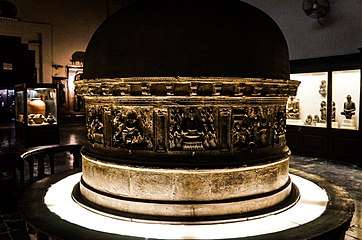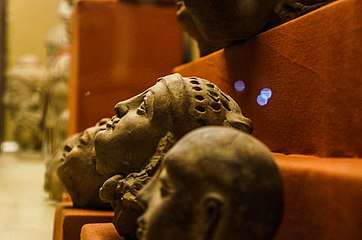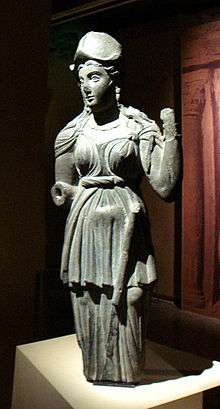Lahore Museum
| عجائب گھر لاہور | |
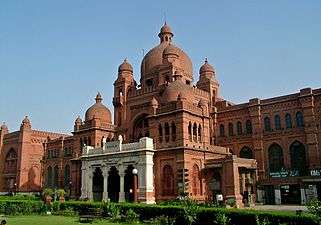 Entrance to the museum | |
|
Location within Lahore | |
| Established | 1865, later shifted to present site 1894 |
|---|---|
| Location |
The Mall, Lahore Punjab Pakistan |
| Coordinates | 31°34′06″N 74°18′29″E / 31.568226°N 74.308174°E |
| Type | Archaeology, art, heritage, modern history, religious |
| Collection size | Pre & Proto, Coins, Hindu Buddhist & Jain, Gandhara, Islamic, Manuscripts, Miniature Paintings, General Collection, Arms, Ethnological, Postage & Stamps, Arts & Crafts, Contemporary Paintings, Pakistan Movement Gallery |
| Visitors | 250,000 in 2005[1] |
| Website | Official website |
The Lahore Museum (Punjabi: لاہور میوزیم; Urdu: عجائب گھر لاہور; “Lahore Wonder House”), is a museum located in Lahore, Pakistan. Founded in 1865 during the British colonial period, Lahore Museum is now one of Pakistan’s most visited and highly regarded museums. The museum, along with the Zamzama Gun located directly in front of the building, were made famous in the celebrated British novel Kim, written by Rudyard Kipling - whose father was one of the museum’s earliest curators. The museum is now also renowned for its extensive collection of Buddhist art from the ancient Indo-Greek and Gandhara kingdoms.
History
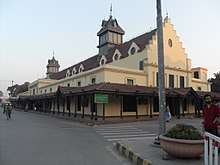
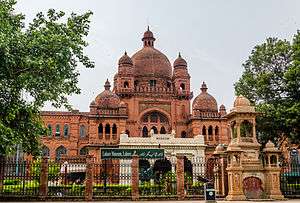
Lahore Museum was originally established in 1865-66 on the site of the current Tollinton Market - a hall built for the 1864 Punjab Exhibition.[2] The museum’s collection was later shifted in 1894 to its present location on The Mall, in Lahore’s British-era core. The present building was designed by the well-known Lahori architect, Sir Ganga Ram.
Rudyard Kipling’s father, John Lockwood Kipling, was one of the museum’s first curators, and was succeeded by K. N. Sitaram. Over 250,000 visitors were registered in 2005.[1]
Collections
The museum has a number of Greco-Buddhist sculptures, Mughal and Pahari paintings on display. The collection contains important relics from the Indus Valley civilisation, Gandhara, and Graeco-Bactrian periods as well. The Fasting Buddha, dating from the Gandhara period, is one of the museums most prized and celebrated objects. The ceiling of the entrance hall features a large mural by renowned Pakistani artist Sadequain.
The museum also contains fine specimens of Mughal and Sikh carved woodwork and has a large collection of paintings dating back to the British period. The collection also includes musical instruments, ancient jewellery, textiles, pottery, and armory, as well as some Tibetan and Nepalese work on display
Scope
The museum displays archaeological materials from pre-historic times to the Hindu Shahi period. It has one of the largest collections of archaeology, history, arts, fine arts, applied arts, ethnology, and craft objects in Pakistan. It also has an extensive collection of Hellenistic and Mughal coins. There is also a photo gallery dedicated to the emergence of Pakistan as an independent state.
Directors
| Name of Directors | Position | Duration |
|---|---|---|
| Percy Brown | Curator | 1899 - 1912 |
| Hugh Lionel Heath | Curator | 1912 - 1929 |
| Rai Bahadur (S.N. Gupta) | Curator | 1929 - 1942 |
| Mr. K. B. Molvi Zarar Hasan | Curator | 1942 - 1947 |
| Malik Shams | Curator | 1947 - 1965 |
| Syed Muhammad Taqi | Curator / Director | 1965 - 1974 |
| Fred. Henry Andrews | Curator | 1893 - 1899 |
| J.L. Kipling (C.I.E) | Curator | 1875 - 1893 |
| Saifur Rehman Dar | Director | 1974 - 1993 |
| F.M. Anjum Rehmani | Officiating Director | 1993 - 1995 |
| Saifur Rehman Dar | Director | 1995 - 1998 |
| F.M. Anjum Rehmani | officiating Director | 1998 - 2001 |
| Mansoor Sohail | Director Additional Charge | 2000 - 2001 |
| Liaquat Ali Khan Niazi | Director | 2001 - 2004 |
| Syed Gulzar Mashhadi | Director | 2004 - 2005 |
| Naheed Rizvi | Director | 2005 - 2008 |
| Asghar Nadeem Syed | Director | 2008 - 2009 |
| Kamran Afzal Cheema | Director | 2009 - 2009 |
| M.Siddique Sheikh | Director | 2009 - 2010 |
| Humera Alam | Director | 2010 - 2012 |
| Sumaira Samad | Director | 2012 - 2016 |
| Himayun Mazhar | Director | Currecnt |
Timings & Entry Fee
Lahore Museum observes working hours as follows:
Winter (October 16 to April 15): 9.00 a.m. to 4.00 p.m.
Summer (April 16 to October 15): 9.00 a.m. to 5.00 p.m.
Adults: Rs.20/-
Children: Rs.5/-
Students: Rs.5/-
Foreigners: Rs.400/-
Camera Charges: Rs.25/-
Note:
The museum is closed on Fridays, and on the first Monday of each month to for collection and building maintenance. It is also closed on Eid-ul-Fitr, Eid-ul-Azha, Eid-i-Milad-un-Nabi, and on the 9th and 10th of Muharram.
Popular culture
- Rudyard Kipling's novel, Kim (pub. 1901), was set in the vicinity of the old/original Lahore Museum and the Mall areas.
Further reading
- Shaila Bhatti (2012), Translating museums: a counterhistory of South Asian museology, Walnut Creek, Calif: Left Coast Press, ISBN 9781611321449
- Whitehead, Richard Bertram (1914). Catalogue of Coins in the Panjab Museum, Lahore; Indo-Greek Coins : Volume 1. The Panjab Government at The Clarendon Press, Oxford.
- Whitehead, Richard Bertram (1914). Catalogue of Coins in the Panjab Museum, Lahore; Coins of Mughal Emperors: Volume 2. The Panjab Government at The Clarendon Press, Oxford.
See also
References
- 1 2 Areas of Attraction - Government of Pakistan Archived 2007-06-10 at the Wayback Machine.
- ↑ Which later became the Tollinton Market after the completion of the new/present museum building, see "Murray's Handbook of the Punjab", pub. 1883. Mention also made in Peter Hopkirk, "Quest for Kim", London, 1996, pp.46-47 ISBN 0-7195-5560-4
- ↑ "Our Directors | Lahore Museum". www.lahoremuseum.gov.pk. Retrieved 2018-04-04.
External links
| Wikimedia Commons has media related to Lahore Museum. |
